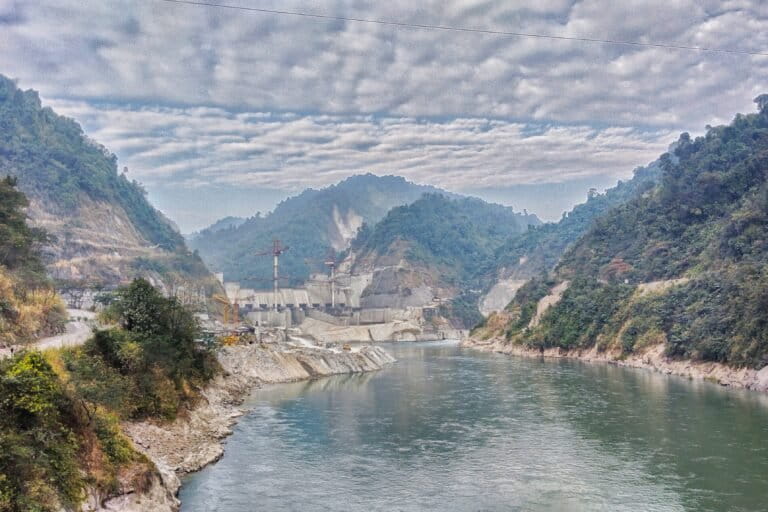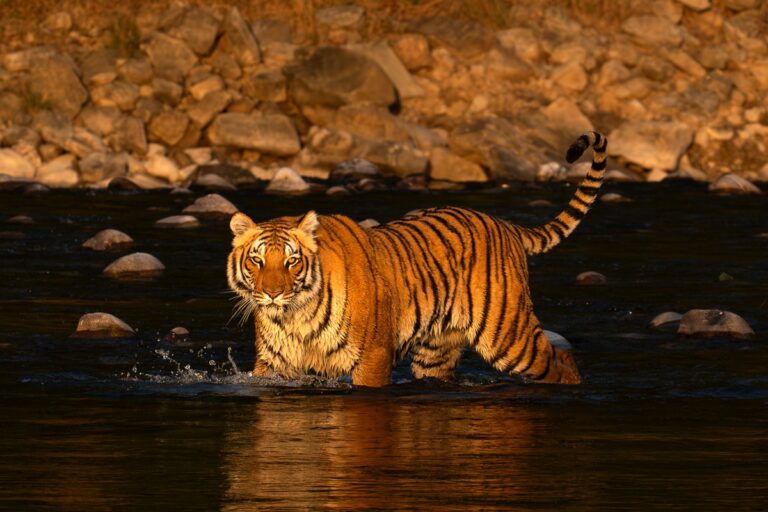- The upcoming Indo-Nepal Border Road could fragment tiger reserves and wildlife sanctuaries, unless the road alignment is revised.
- The construction of the road outside the protected areas has started even as approvals from the forest department and wildlife board remain pending.
- The road falls in Seismic Zone IV and the four rivers that flow through the project area get flooded every monsoon.
Development projects across the country continue to disturb natural habitats, ecosystems and wildlife, leaving areas vulnerable.
Tiger reserves and wildlife sanctuaries are under threat along the upcoming 1,715-kilometres long Indo-Nepal Border Road that aims to connect 154 border outposts of Sashastra Seema Bal (SSB), India’s armed border force, across seven border districts (Pilibhit, Lakhimpur Kheri, Bahraich, Shravasti, Balrampur, Siddharthnagar and Maharajganj) in the northern state of Uttar Pradesh (U.P.). The two-lane strategic road, which is now under construction at different stretches, will largely run parallel to the borders connecting the outposts to boost their mobility in difficult terrain like hills, rivers and forests, while keeping vigil.
However, of the 574 kilometres of the Uttar Pradesh stretch of this ambitious project, 302 kilometres falls under forest land, two tiger reserves (Pilibhit, Dudhwa) and three wildlife sanctuaries (Suhelwa, Katarniaghat and Sohagi Barwa). While the state public works department (PWD) is laying the first phase of 237 kilometres in low lying areas, the state forest department has raised red flags over the second phase, opposing the passage of the road through the protected Terai region, which has rich habitats of diverse flora and fauna.

Terai is a low-lying area in the foothills of the Himalayas and home to some of the most crucial tiger habitats of the country, including Corbett national park, Dudhwa national park and the Chitwan national park of Nepal. It supports an estimated 485 Royal Bengal tigers.
Destruction of wildlife habitat, felling of large number of trees and disturbance in tiger and elephant corridors between India and Nepal forests have been cited by forest officials as the prime reasons for opposing the project. According to officials, who have sought a revision of the road alignment in consultation with the SSB, the Terai region also encompasses wetlands and breeding and nesting of protected species of reptiles and migratory birds. “The plan in its current shape will disturb the habitat of tigers, other wild animals and birds. The alignment of the road needs to be changed in a way that protected areas are not fragmented,” forest officials, who preferred to remain anonymous, said.
Green approvals pending
Satyendra Kumar Srivastava, chief engineer, Indo-Nepal Border Road Project, PWD, Uttar Pradesh, confirmed to Mongabay-India that around 100 km of the road falls under the purview of forest department while 200 km falls in the purview of the state wildlife board.
At the time of clearance of this project in 2014, the Union Ministry of Environment, Forests and Climate Change (MoEFCC) had stated that forest clearance was not required by state PWD since the proposed road was neither a national highway nor a state highway or expressway. However, the PWD was advised to get a go-ahead from the state forest department for diversion of forest land under the Forest (Conversion) Act 1980 and wildlife clearance from the National Board for Wildlife (NWBL) under the Wildlife (Protection) Act 1972.
NBWL’s nod is expected to come only when the State Board for Wildlife (SBWL) submits its recommendations. Meanwhile, even though the approvals from the forest department and wildlife board are pending, the PWD has started construction of the road outside the protected areas.
National parks and wildlife sanctuaries in jeopardy
Nepal shares a border of over 1,850 kilometres with five Indian states – Sikkim, West Bengal, Bihar, Uttar Pradesh and Uttarakhand. The porous borders often provide free routes for fake currency, drugs and illegal foreign goods.
On the Uttar Pradesh side, the new road, between seven to 15 meters wide, will start from Pilibhit Tiger reserve and pass through the Dudhwa Tiger Reserve and then through three wildlife sanctuaries – Katarnia Ghat, Suhelva and Suhagibarva. Tigers, elephants and the greater one-horned rhinoceros are three flagship species in the region apart from leopards, varieties of deer, antelopes, elephants, jackal and hyena. Katarniaghat comprises a mosaic of sal and teak forests with lush green grasslands. The Gairwa river that flows here is declared as a sanctuary for crocodile and turtles. It is one of the few places in the world where Gangetic dolphins are still found.

“The road would eat up 2.87 square kilometres of the protected forest areas. Suhelva and Dudhwa Parks are set to lose large chunks, 2.69 and 1.67 square kilometres respectively. Pilibhit Tiger reserve will lose 0.72 square kilometres, Katarniaghat 1.5 square kilometres and Sohagibarva 0.042 hectares,” officials said.
The Terai region forests provide a vital corridor for wildlife to travel across the borders. According to a senior forest official who wished to remain anonymous, “Two major wildlife corridors fall in Dudhwa range from where tigers and elephants migrate to Nepal’s Shuklaphanta Wildlife Reserve and Bardia National Park. The proposed road will disturb these routes.”
Moreover, the project will involve felling of 55,000 trees, many over 200 years old. “Approx. 200 tree per ha of forestland/ National Park/ Wildlife Sanctuary would be cut which include sal, sheesham, asna, khair, roni – all timber,” reads the environment clearance letter from the Union Ministry of Environment, Forests and Climate Change, which promises compulsory afforestation.
Concerns over feasibility
Forest officials have also raised concerns over the durability of the proposed road. They fear the road will not last even for five years and all the expenditure will go in vain because the four rivers – Ghaghra, Saryu, Rapti and Sharda – that flow in the project area get flooded every monsoon. Over 28 major and 239 minor bridges have been proposed over these rivers along the road.
Besides, the project falls under Seismic Zone IV.

“This is a bizarre project. Roads on borders are already available. So, this additional venture is useless especially when it would fragment our forests and impact wildlife,” said ecologist A.J.T. Johnsingh, who had surveyed the project area and submitted his recommendations to the government.
Solution lies in existing roads, fire lines says forest dept
The forest department suggests using existing roads and fire lines in the protected areas instead of laying fresh roads. “Fire lines/roads (areas cleared of vegetation to curb forest fire) are usually 15 metres wide. The SSB already uses these lines at many places; they can be upgraded,” said Pankaj Mishra, chief conservator of forests (nodal officer, forest conservation), Uttar Pradesh.
Forest officials cite the example of Bihar, which has ensured that its protected areas are not disturbed due to this road. According to Ramesh Pandey, chief conservator of forests and field director of Dudhwa Tiger Reserve, “Since this road won’t be a public road and aims to connect only border outposts of SSB, it would be better if existing infrastructure is utilised in the protected areas. Bihar has done that to save the fragmentation of Valmiki Tiger Reserve, near the Indo-Nepal border.” According to him, these suggestions have been submitted to the chief wildlife warden (CWLW) a month ago. The CWLW is yet to submit the report to the State Board of Wildlife (SBWL) whose chairperson is U.P. chief minister Yogi Adityanath.
The forest department is hopeful that their suggestions would be taken into consideration. “The chief minister had instructed board members to ensure that loss of forests is minimised,” he said. “The report will be tabled at the next meeting of the board,” said Anand Srivastava, deputy conservator of forests. The last board meeting was held in August 2018; there is no clarity about when the next one might be scheduled.

We are just an implementing agency: PWD
The state PWD pleaded helplessness when quizzed about the situation.
“PWD is only implementing this project. We have provided the best possible alignment to the forest department. Any further amendments in alignment, sought by them, need to be approved by the state and national wildlife boards. We will abide by all the recommendations of statutory bodies,” said Srivastava.
On the durability of the road, Srivastava said, “This road will have a life span of 10 to 15 years, just like any other road. Proper measures will be taken to minimise the impact of earthquakes.” According to him, the delays in approvals for the project, which was conceptualised in 2010 by the Union Ministry of Home Affairs at an estimated cost of Rs. 1,600 crore (Rs. 16 billion), is now expected to cost Rs. 3,000 crore (Rs. 30 billion), said Srivastava, adding that the deadline for completion has been set for 2022.
Banner image: Dudhwa National Park on the Indo-Nepal border. Photo by Koshy Koshy/Flickr.














